Should we use a genetic weapon against mosquitoes carrying malaria?
The African public may get the final say on running one test of gene-editing tools

Scientists are testing a gene-editing technique called a gene drive to stop malaria mosquitoes from reproducing. These test rooms are in a laboratory in Terni, Italy.
Courtesy of Target Malaria
Share this:
- Share via email (Opens in new window) Email
- Click to share on Facebook (Opens in new window) Facebook
- Click to share on X (Opens in new window) X
- Click to share on Pinterest (Opens in new window) Pinterest
- Click to share on Reddit (Opens in new window) Reddit
- Share to Google Classroom (Opens in new window) Google Classroom
- Click to print (Opens in new window) Print
In a large laboratory cage, a male mosquito carries a genetic weapon that could launch the destruction of his species. That loss could also mean the end of the parasite that causes malaria.
The weapon? A self-replicating bit of DNA known as a gene drive. It’s one of the most anticipated tools being developed to stop mosquitoes from spreading diseases like malaria to humans. It’s also one of the most controversial.
The gene drive interferes with the insects’ ability to reproduce. In one small lab study, it wiped out captive populations of mosquitoes in just eight to 12 generations. A larger study in outdoor cages in Terni, Italy, worked too. Within as little as five to 10 years, this gene drive could be ready to test in the wild.
Researchers are eyeing Africa for the first test release. There, malaria takes a huge toll. In 2020, it sickened close to 241 million people on the continent. And most of the globe’s 670,000 malaria deaths that year were in Africa. About eight in every 10 were children, the World Health Organization says.
Many tools have been made to fight the disease. There are preventive drugs, insecticide-treated bed nets and even vaccines. These efforts are helping. But mosquitoes are developing resistance to insecticides. And some anti-malaria drugs may no longer work well.
“To go toward zero [cases], we need to have something that is transformational,” says Fredros Okumu. By that, he means a completely new type of strategy. Okumu is a mosquito biologist. He directs science programs at Ifakara Health Institute in Tanzania, a country in East Africa.
Gene drives might be the big change people are looking for. This technology was first devised in 2015. Researchers are still refining and testing it. Other types of genetically altered mosquitoes have been released in Brazil, the United States and elsewhere. But so far, those altered genes spread slowly among wild populations. Gene drives could potentially spread to nearly every member of a species quickly. In this way, they could forever alter the species. Or even wipe it out.
With such big changes possible, there’s more than just science at stake. So social considerations may play a big role in deciding whether gene drives ever get used.
Ramya Rajagopalan is a social scientist at the University of California, San Diego. “A technology doesn’t work by technical strength alone,” she says. “It works because it embeds into a social context.” In the past, scientists “developed a technology in the lab, got it all set up and ready to go.” Then they would offer it up: “Hey, we have this great technology, do you want to use it?”
But people sometimes reject that sort of offer. Some genetically modified crops, for example, haven’t been well received. Researchers often think this is because people just don’t know better. The scientists may think, “If [the public] only knew enough about the technology, they’d be more accepting,” Rajagopalan says. But more often, she says, there’s a bigger issue. The failure comes because the researchers “don’t include community voices from the outset in the design and the implementation.”
The European Union has already said “no” to using gene drives there. That’s due to concerns about forever altering ecosystems.
But Africa is where a gene drive might one day help defeat malaria. In several countries there, researchers are working with a nonprofit research group called Target Malaria. They hope to eventually release gene drives on the continent. First, they must get public agreement. To that end, scientists are looking for ways to involve community members in the research. Those researchers need to learn about local priorities. And they have to know how to talk about the technology in ways the public can understand.
Rattling the cage
No one is ready to let mosquitoes carrying gene drives out of the lab just yet. For now, researchers are doing tests with mosquitoes in captivity. They want to get an idea of whether the technology will work as planned.
The study in Terni used cages that were almost 5 cubic meters — about the size of a small dressing room. Each held hundreds of Anopheles gambiae mosquitoes. The scientists mimicked humidity, lighting and other conditions the mosquitoes might find in the wild. Then they added males that carried the gene drive in their DNA.
The gene drive used for this experiment is built with the gene-editing tool known as CRISPR/Cas9. This tool allows scientists to tweak nearly any gene they want. It’s based on a DNA-snipping enzyme called Cas9. This gene drive targets a gene named doublesex. It’s essential for the development of female mosquitoes. When the gene doesn’t work, “the mosquito itself doesn’t work,” says Ruth Müller. She’s chief ecologist and entomologist at the Institute of Tropical Medicine in Antwerp, Belgium. She was one of the study’s leaders.
Male mosquitoes were engineered to carry the gene drive. When such a male mates with an unaltered female, the Cas9 snips the doublesex gene inside the fertilized egg. As the egg tries to repair the cut DNA, the gene drive sometimes gets pasted over the copy of the doublesex gene inherited from the mother. These offspring now get two copies of the gene drive, not just one.
Normally, any particular version of a gene has a 50 percent chance of being passed from parent to offspring. But the copy-and-paste CRISPR system boosts that chance. With the doublesex gene drive, about 96 percent of male offspring inherited the altered gene. So did more than 99 percent of females. That helps the gene drive spread rapidly through the population.
Upping the odds
Most forms of genetic engineering follow normal rules of inheritance. Usually a gene is passed on to only 50 percent of offspring. But a gene drive can paste itself into a gene inherited from an unaltered parent. That passes the genetic change to nearly all of the offspring.
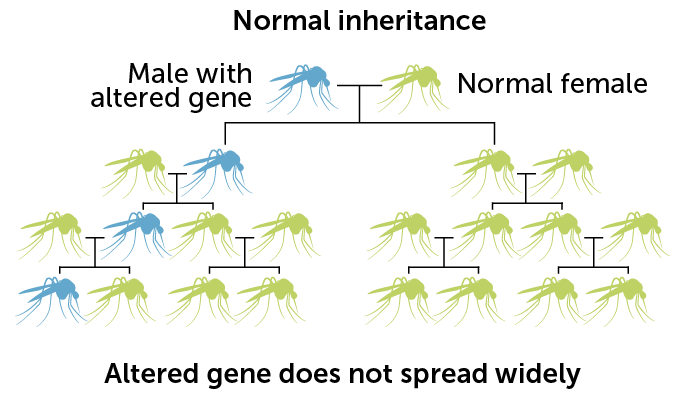
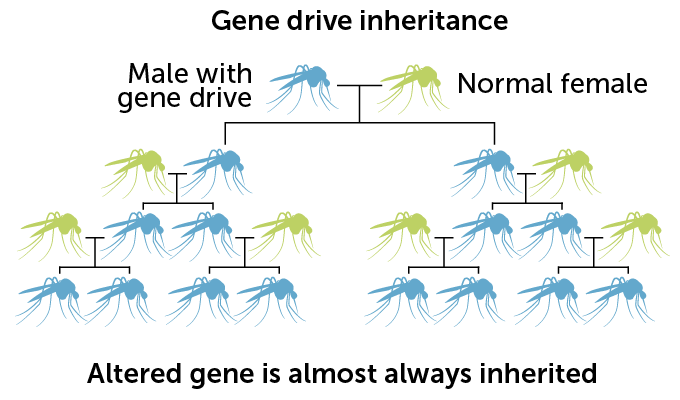
Female offspring that inherit two bad copies of doublesex end up malformed. They are sterile, so they can’t reproduce. And they cannot bite people. That means they can’t spread malaria.
The gene drive worked well in the cages in Terni. When males carrying the gene drive were added, the populations died out in 245 to 311 days. In two other cages, no gene-drive mosquitoes were added. There, the mosquitoes lived normally to the end of the experiment. The researchers reported the results last year in Nature Communications.
Considering all possibilities
The Terni results show the gene drive might work under almost real-world conditions, says Müller at the Institute of Tropical Medicine. But there is still much to learn about drives, she adds. That includes how they will affect wild mosquitoes and ecosystems.
Several groups are mapping out what releasing a gene drive could do to the planet. No one has ever done this before. So it takes a mix of guesswork and data to predict possible outcomes.
As a first step, researchers tried to dream up potential drawbacks. That helped identify what they might need to plan for and test before releasing gene-drive mosquitoes into the wild. They could also weigh risks and benefits. They focused on four areas that African leaders said were most important to protect: biodiversity, human health, animal health and water quality.
Altogether, they came up with at least 46 possible harms that might come from releasing gene drives in mosquitoes. Might animals that eat mosquitoes struggle, for example, if the targeted mosquitoes disappeared? Might people develop allergic reactions to the bite of mosquitoes that had a single copy of the gene drive? Might large numbers of dying mosquito larvae worsen water quality? Might a gene drive even lead to more cases of malaria? For instance, could thinning out less-troublesome mosquitoes allow better disease-spreaders to take over? Malaria Journal published the full list of concerns in March 2021.
Researchers then worked out a chain of events that might lead to each of the potential harms on the list. With that starting point, scientists may now be able to start calculating how likely a harm is and how bad it could be, says John Connolly. He’s a senior regulatory scientist for Target Malaria. He works in England at Imperial College London and helped write the report.
“You probably never really finish a risk assessment,” Connolly says. “But you get a clearer understanding of the risks and uncertainties.” The team can also identify what types of existing data might be helpful. The release of genetically altered mosquitoes that don’t carry gene drives could give useful data, for one. So could studies of past introductions of species, such as predators used to try to wipe out invasive species.
Keith Hayes leads a risk-assessment group at the Commonwealth Science and Industrial Research Organization’s Data61. It’s in Hobart, Australia. Experiments and simulations are useful to a point, he says. But, he adds, “We can’t know everything. There may be surprises.” So some questions won’t be answered unless and until gene drives get released.
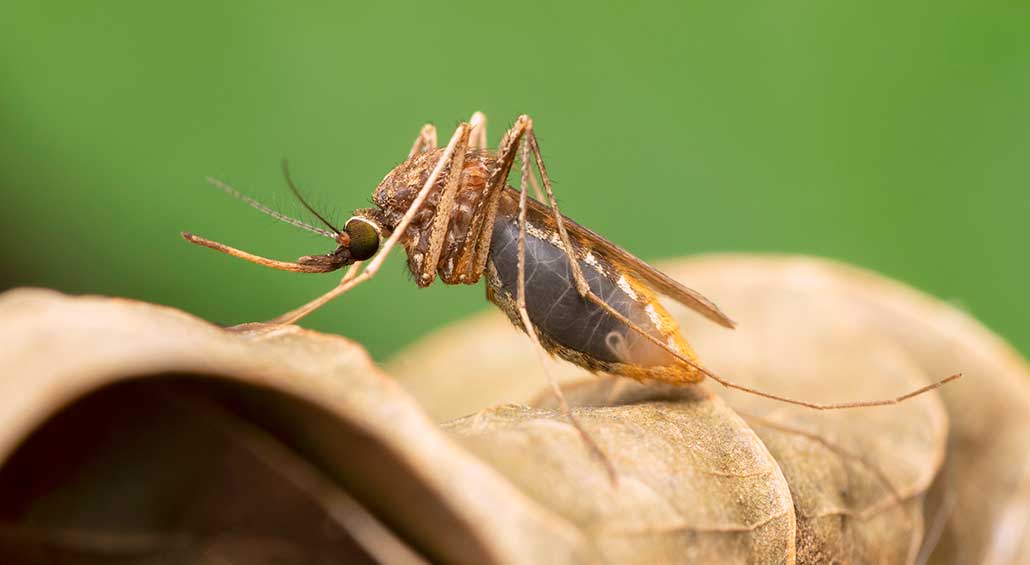
High stakes
In the end, any decision about a release will need to weigh risks against benefits. The potential benefits for human health and their costs may far outweigh the risks, Müller argues. “If you have a high burden of malaria, that costs a lot,” she notes. “Children cannot go to school. People cannot go to work.”
Opponents of gene drives say the world should invest more in already-proven methods of curbing malaria, says Mareike Imken. Such measures include improving sanitation and the medical system, she says. Imken works as European coordinator of the Stop Gene Drives campaign. Her organization is calling for a global ban on the release of gene drives. First, it says, there needs to be worldwide agreement on whether gene drives are safe and necessary. Countries also must decide how gene drives might be regulated.
Okumu notes that insecticides and other current approaches to malaria control haven’t been effective enough. “The stuff we have been doing for years has been intentionally designed to eradicate mosquitoes,” he says. And “it just didn’t do it.”
He also notes potential upsides to gene drives. Insecticides kill a lot of helpful insects, such as bees, butterflies and other pollinators. In contrast, Okumu notes, gene drives target only the mosquito species that are dangerous. That’s a tiny fraction of just mosquitoes. Only a handful of species are responsible for most malaria spread. In Africa, the main disease carriers are Anopheles gambiae and its look-alikes An. arabiensis, An. coluzzii and An. funestus.
Okumu’s experience leads him to think the malaria carriers wouldn’t be missed much if wiped out. His home village is in Tanzania. In that region, a combination of factors has pushed An. gambiae out. They include prolonged dry seasons and use of both insecticides and bed nets. Communities there haven’t seen any ecological problems since the species’ loss, he says. He notes, though, that there could be factors they didn’t measure.
It’s also possible, Okumu says, that if one Anopheles species disappeared, another might move in to take its place. That could be a good thing. The replacements might bite people less or be lousy at spreading malaria. Then again, it could be worse if the newcomers bite more or more easily spread the parasites.
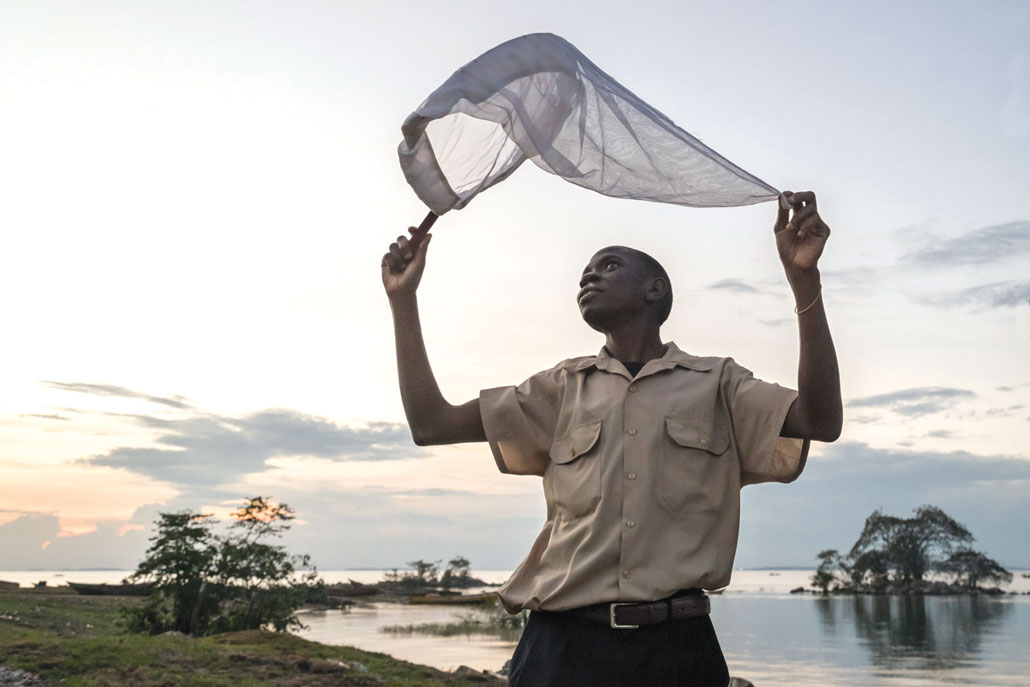
Community input
Beyond the science concerns, researchers must also get public support for releasing the technology. Without that, even a gene drive that works perfectly could be a no-go.
Not everyone agrees on when and how to get input. Okumu thinks it’s important to have more answers about the science first. “I would rather we know the true benefits, the true risks and gain a consensus around it,” he says. Then, he thinks, scientists could “start engaging the communities.”
Lea Pare Toe disagrees with that approach. She’s a social scientist at the Institut de Recherche en Sciences de la Santé in Bobo-Dioulasso. That’s in the West African nation of Burkina Faso. “We should listen to [the community],” she says, and then “develop the science together.”
Toe works with Target Malaria to engage local people in the research. At Bana, in her country, researchers didn’t start out talking about genes at all, she says. First, the team had to clarify the link between mosquitoes and malaria. They also had to dispel myths, such as that eating fatty foods or sweet fruit can cause the disease. The researchers led an intensive campaign from 2014 through 2019. Afterward, they found that such false statements were far less accepted. The researchers reported this in Malaria Journal in October 2021.
Fact vs. fiction
A Target Malaria effort engaged local residents in Bana, Burkina Faso, in plans to use genetically modified mosquitoes. Talks over five years cleared up some misconceptions about how malaria is transmitted.
Community agreement on false statements about mosquitoes and malaria in 2014 and 2019
| Misconceptions about mosquitoes and malaria | 2014 % agree (Respondents: 179) | 2019 % agree (Respondents: 149) |
|---|---|---|
| All mosquitoes transmit malaria | 76.3 | 16.1 |
| Male mosquitoes transmit malaria | 77.7 | 10.1 |
| Seasonal fruits transmit malaria | 13.9 | 0.9 |
| Fatty foods transmit malaria | 34.6 | 1.3 |
Then Toe and her colleagues introduced the idea of genetics. They talk about how researchers want to change mosquitoes to fight malaria. People are generally fine with the uncertainty of research, she says. Still, they want to know more.
Residents can now pose specific questions about mosquito biology. They might ask how researchers can possibly work with such small creatures. They often ask whether the gene changes in mosquitoes will transfer to humans. People “love the details,” Toe says.
Sometimes, creative approaches are needed to get the science across. For instance, Target Malaria planned to release a test batch of mosquitoes to see how they fared in the wild. These didn’t carry gene drives, but they were genetically altered.
First, the organization wanted to ensure that Bana residents really understood what it planned to do. Local leaders suggested a play. The scientists wrote a script. Then the actors, a local storyteller and other community members revised it to improve storytelling. This helped create an emotional connection with the audience, Toe says. She and colleagues described it this past April in Humanities and Social Sciences Communications.
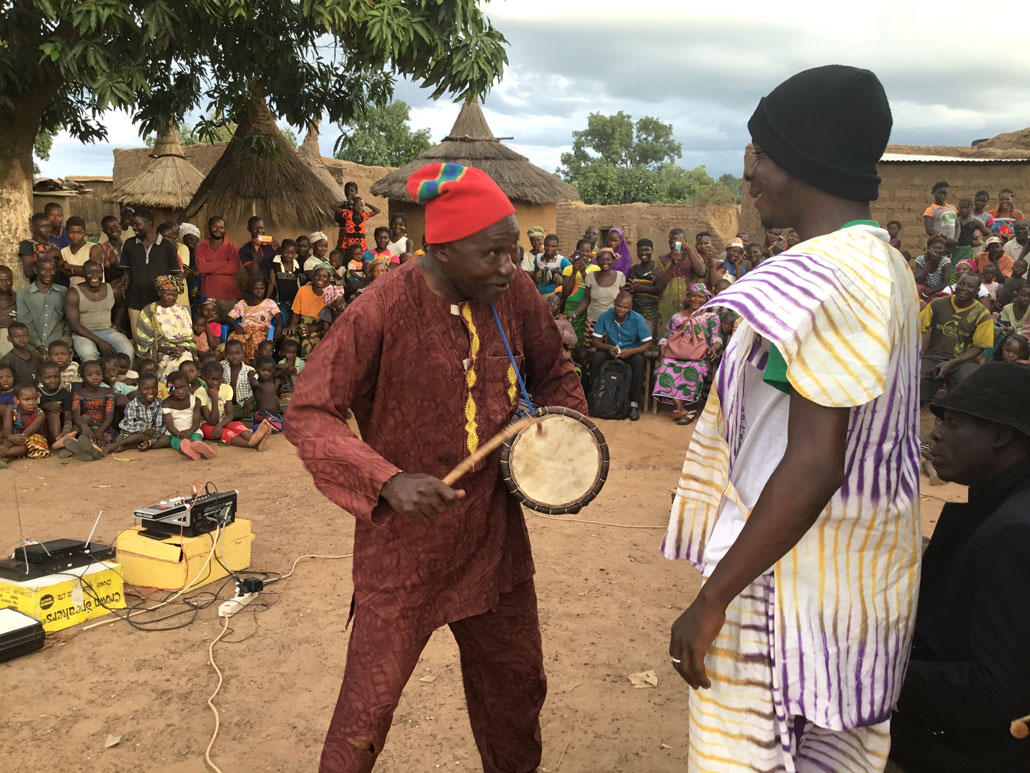
Talking with communities can also raise questions for researchers to think about. In 2019, Okumu and his colleagues talked with village leaders and residents in southeastern Tanzania. People had concerns about whether the altered mosquitoes would look and behave differently than normal ones. They also said it would be better to get rid of all biting mosquitoes. Targeting just one type might not have much effect on malaria. And people might be less likely to support the project if they were still getting bit.
In a study in nearby Uganda, people asked what happens if the altered mosquitoes cross a nation’s borders. Researchers may have to seek international permission to release gene drive mosquitoes.
To gain support for gene drives, it probably helps that they will first target disease-carrying mosquitoes. “Do you know anyone who has sympathies for the mosquito? It’s probably the most hated animal on the planet,” says Kimberly Cooper. She studies genes and animal development at the University of California, San Diego. She is developing a gene drive to use as a research tool in mice.
Still, the benefits of stamping out malaria could be enormous. Do they outweigh potential environmental risks from gene drives? Will the public buy into this new approach? No one yet knows.
“There are tons of unknowns,” Okumu says. “The question is, ‘Should we pursue it?’ If you ask me, it would be unethical not to.”







